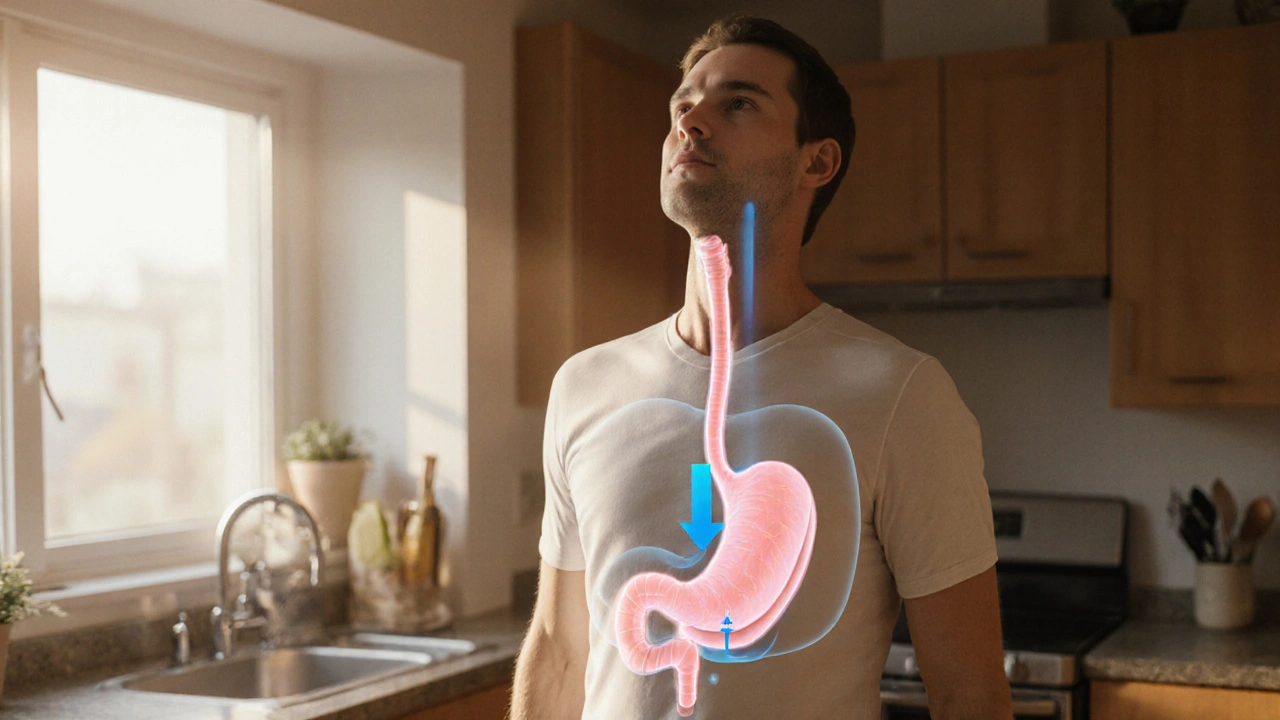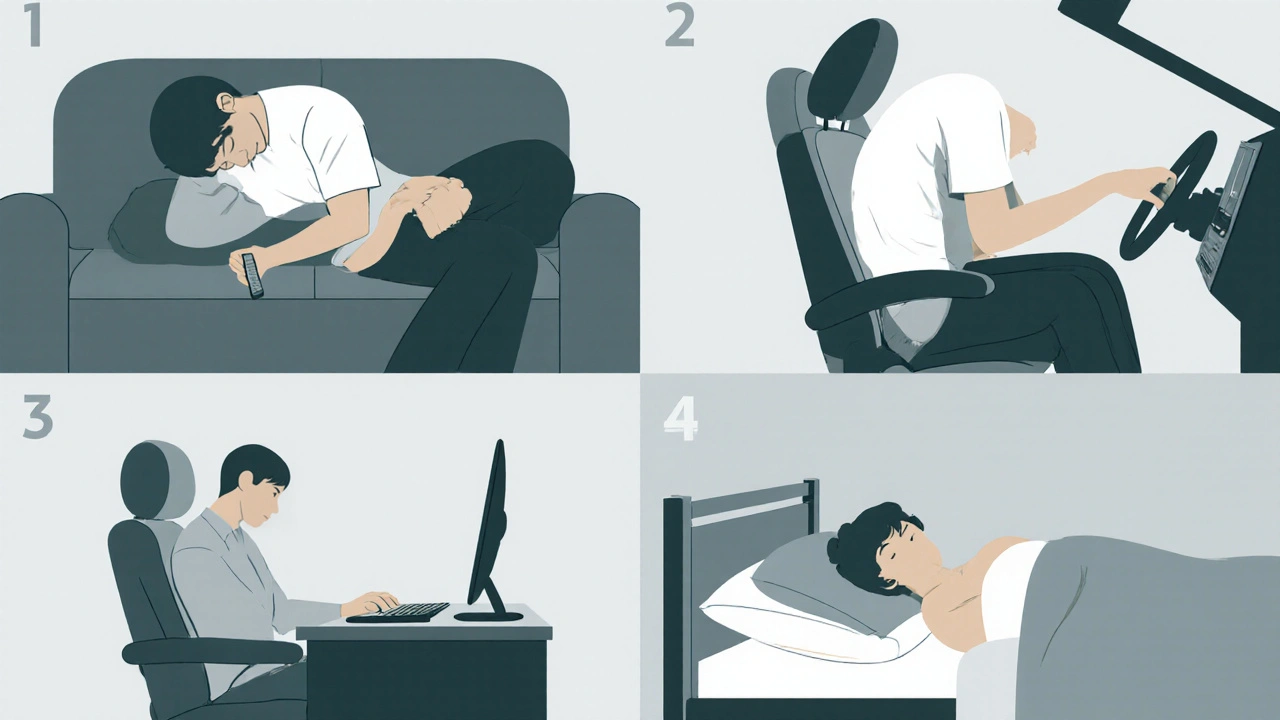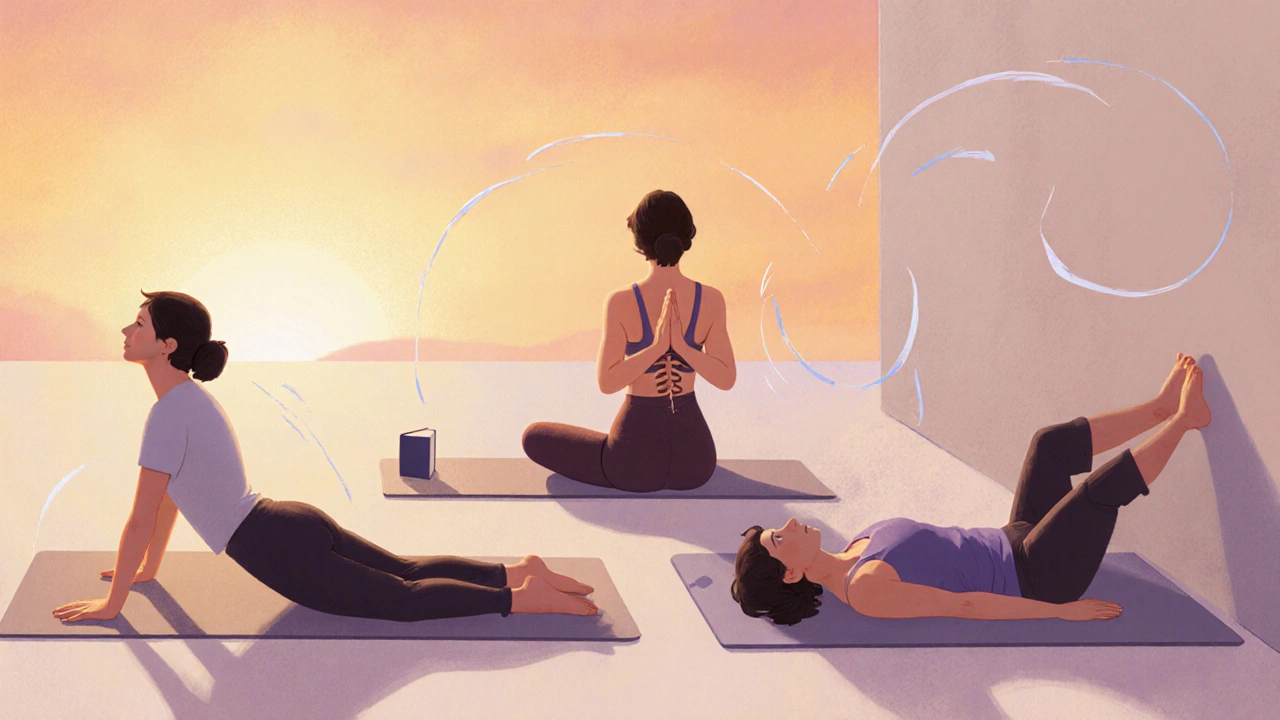
Posture & Heartburn Impact Calculator
This tool helps you assess how posture affects heartburn risk and suggests improvements.
Your Posture & Heartburn Risk Assessment
Quick Takeaways
- Upright posture keeps the esophagus above the stomach, reducing acid flow.
- Slouching after meals can double the chance of heartburn.
- Simple spine‑friendly habits-standing tall, sitting back, and gentle core work-cut symptoms for most people.
- If symptoms persist despite good posture, talk to a doctor about GERD treatment.
- Regular posture checks are a low‑cost way to protect your digestive health.
What Is Heartburn and Why It Happens
When stomach acid backs up into the Esophagus the tube that carries food from the mouth to the stomach, you feel a burning sensation in the chest. This discomfort is commonly called Heartburn a symptom of acid reflux where stomach acid irritates the lining of the esophagus. While occasional heartburn is normal, frequent episodes point to gastro‑esophageal reflux disease (GERD a chronic condition where acid regularly flows back into the esophagus).
Most people think the problem lies only in what they eat, but body position plays a huge role. Gravity is the body’s natural guard against acid climbing upward. When you’re upright, gravity helps keep the stomach contents down. Change the angle, and that guard weakens.

How Body Position Changes Acid Flow
The Diaphragm a dome‑shaped muscle separating the chest cavity from the abdomen works like a valve. It squeezes the stomach and keeps the lower esophageal sphincter (LES) closed. Slouching compresses the abdomen, pushes the stomach upward, and forces the LES to open wider.
When you sit with a rounded back, the angle between the stomach and esophagus narrows. This “kink” creates pressure that pushes acid toward the LES, making it more likely to leak. In contrast, an upright spine aligns the stomach below the LES, letting gravity do its job.
Common Scenarios Where Bad Posture Triggers Heartburn
- After meals: Many people lounge on the couch, hunch over the TV, or work on a laptop while digesting. The forward‑leaning position adds pressure on the stomach.
- While driving: The seatbelt and steering wheel often force a slight forward tilt, especially on long trips.
- At a desk: Slipping into a low chair or typing with shoulders hunched can become a habit that lasts for hours.
- In bed: Going to sleep right after dinner and lying flat lets acid travel easily up the esophagus.
Research from the Australian Digestive Health Institute (2024) found that participants who adopted a straight‑back posture after meals reported a 38% reduction in heartburn episodes over two weeks.
Practical Tips for Maintaining Proper Posture
Below is a quick‑reference table you can print or keep on your phone. Each tip targets a specific part of the posture‑acid connection.
| Situation | What to Do | Why It Helps |
|---|---|---|
| After meals (30‑60 min) | Stand or sit upright, shoulders back, knees slightly bent. | Keeps stomach below the esophagus, letting gravity pull acid down. |
| Desk work | Adjust chair height so thighs are parallel to the floor; use a lumbar roll. | Maintains natural spinal curve, reducing abdominal pressure. |
| Driving | Set the seat so your hips are level with your knees; use a small cushion for lumbar support. | Prevents forward tilt that pushes stomach upward. |
| Watching TV | Sit on a firm couch with a straight‑back chair; avoid slouching onto a pillow. | Reduces compression of the abdomen. |
| Going to bed | Elevate the head of the mattress 6‑8 inches or use a wedge pillow. | Creates a slight incline, letting gravity keep acid down. |
Remember, the key is consistency. A brief posture check every hour can keep the habit alive.

Simple Exercises to Support a Healthy Spine
- Cat‑Cow Stretch (2 minutes): Start on hands and knees, arch your back up (cat) then dip it down while lifting the head (cow). This mobilises the thoracic spine and eases tension.
- Seated Chest Opener (1 minute): Sit tall, clasp hands behind your back, and gently lift the arms while pulling shoulders down.
- Diaphragmatic Breathing (5 breaths): Lie on your back, place a book on your belly, inhale deep so the book rises, exhale slowly. Strengthens the diaphragm and reduces internal pressure.
- Wall Angel (2 minutes): Stand with your back to a wall, elbows at 90°, slide arms up and down like a snow angel while keeping contact with the wall.
Doing these moves after each meal can improve spinal alignment and boost the diaphragm’s ability to keep the LES closed.
When to Seek Professional Help
If you’ve tried posture adjustments and lifestyle tweaks but still experience burning more than three times a week, it’s time to talk to a clinician. Warning signs include:
- Difficulty swallowing or feeling food stuck.
- Persistent cough, hoarseness, or sore throat.
- Weight loss or loss of appetite.
- Chest pain that mimics a heart attack (always get it checked).
Doctors may prescribe proton‑pump inhibitors, recommend a tailored diet, or suggest a pH monitoring test to confirm GERD.
Frequently Asked Questions
Can sitting upright really stop heartburn?
Yes. An upright spine keeps the stomach lower than the esophagus, letting gravity pull acid away from the LES. Studies show a noticeable drop in symptoms within minutes of straightening up after a meal.
How long should I stay upright after eating?
Aim for at least 30‑60 minutes. The stomach’s initial digestion phase is when acid production peaks, so keeping a vertical posture during that window helps most.
Do pillow‑filled mattresses worsen heartburn?
Soft mattresses can allow the spine to sink, increasing abdominal pressure. A firmer surface or a wedge pillow keeps the torso slightly elevated, reducing reflux.
Is exercising after meals bad for heartburn?
High‑impact activities like running can jostle the stomach and trigger reflux. Gentle stretching, walking, or the exercises listed above are safe and actually supportive.
Can weight loss improve posture‑related heartburn?
Losing excess belly fat reduces pressure on the stomach and LES, making it easier to maintain a neutral spine. Combined with posture awareness, it often eliminates mild reflux.
By paying attention to how you hold your body, you give your digestive system a simple yet powerful advantage. posture isn’t just about a better look-it’s a frontline defense against heartburn.




Leah Robinson
October 6, 2025 AT 16:57Wow, this is such a helpful rundown! 👏 Keeping your spine tall after meals is such a simple hack, and the science behind it is pretty solid. I love the tip about the wedge pillow – it’s an easy win for bedtime. If you can spare a few minutes for a short walk, that’s even better for digestion. Keep experimenting and find what feels right for you. You’ve got this! 😊
Abhimanyu Lala
October 6, 2025 AT 22:31lol u think posture can fix everything? meh, try it quick.
Richard Sucgang
October 7, 2025 AT 02:41While the anecdotal evidence presented is compelling, one must consider the underlying physiological mechanisms with a more rigorous lens. The interplay between diaphragmatic tension and lower esophageal sphincter competence is indeed nuanced. Moreover, postural alignment does not operate in isolation; dietary factors and gastric emptying rates remain pivotal. Consequently, any prescriptive advice ought to be contextualized within a holistic therapeutic framework. Nonetheless, the practical recommendations are commendable and merit further empirical validation.
Russell Martin
October 7, 2025 AT 09:37Hey folks! Quick pro tip: set a timer for 30‑45 minutes after you eat and stand up for a quick stroll or do some light stretches. It’s amazing how much less pressure you feel on your stomach when you’re not slouched. Also, adjust your chair so your hips are level with your knees – that little change makes a big difference in keeping that acid down. Give it a try and let us know how it works for you!
Jenn Zee
October 7, 2025 AT 12:57It is imperative that we approach the discourse surrounding postural influence on gastro‑esophageal reflux with a heightened sense of moral responsibility, for the ramifications of neglecting such seemingly trivial adjustments extend far beyond mere discomfort. First, consider the societal neglect of basic ergonomic education, a failure that implicitly encourages the populace to succumb to preventable ailments. Second, the propagation of sedentary lifestyles, glorified by modern media, directly contributes to the maladaptive spinal curvatures that exacerbate reflux. Third, by disregarding the simple act of maintaining an upright spine, individuals endorse a culture of complacency that undermines public health initiatives. Fourth, the neglect of proper nocturnal positioning, such as eschewing wedge pillows, signals a disregard for evidence‑based recommendations that could alleviate night‑time symptoms. Fifth, the casual dismissal of post‑meal walks betrays an indifference to holistic wellness. Sixth, failing to adjust workstations for lumbar support reflects a broader systemic oversight within occupational health standards. Seventh, the romanticization of slouching as a fashionable posture perpetuates myths that are detrimental to digestive health. Eighth, the lack of interdisciplinary collaboration between gastroenterologists and physiotherapists exemplifies an alarming silo mentality. Ninth, the absence of public health campaigns emphasizing the gravity of posture in reflux management reveals a troubling gap in preventive strategies. Tenth, the reliance on pharmacological interventions without addressing mechanical contributors is a short‑sighted approach that neglects the root cause. Eleventh, the commercial exploitation of “comfort” products that encourage reclined positions further entrenches harmful habits. Twelfth, the dismissal of patient education as a mere afterthought undermines empowerment. Thirteenth, the tendency to attribute heartburn solely to spicy foods ignores the multifactorial nature of the condition. Fourteenth, the failure to recognize the integral role of diaphragmatic breathing in maintaining LES tone is a glaring oversight. Finally, we must collectively acknowledge that advocacy for upright posture transcends personal comfort; it is an ethical imperative to foster a healthier society.
don hammond
October 7, 2025 AT 17:57Oh great, another "posture is the cure-all" post 🙄. Sure, stand up straight, drink water, and maybe the universe will stop rebelling against your stomach. If only we could solve world hunger by just sitting up a bit higher, right? 🤷♂️
Ben Rudolph
October 7, 2025 AT 20:44Fine.
Ian Banson
October 8, 2025 AT 05:04Honestly, most of this is common sense. Everyone knows that lying down after a big meal makes you feel like a furnace. The real issue is that people ignore basic bodily signals and think they’re too busy to adjust a chair. If you’re serious about health, stop making excuses and just sit up.
marcel lux
October 8, 2025 AT 09:14Thank you for the thorough guide. I appreciate the blend of practical tips and scientific background. It would be great to see a downloadable checklist for quick reference. Let’s keep sharing evidence‑based strategies to help each other.
Charlotte Shurley
October 8, 2025 AT 14:47This information is valuable, especially the part about using a wedge pillow at night. I will consider integrating the suggested posture checks into my daily routine.